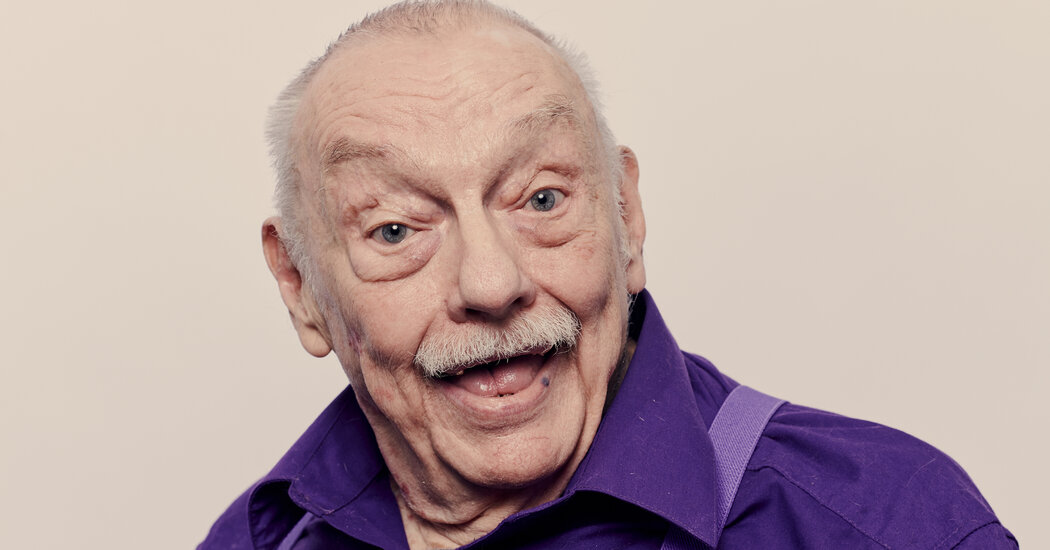In addition to his elaborately staged images of gay fantasies, he made the film “Pink Narcissus,” a cult classic released anonymously in 1971.
James Bidgood, who elevated campy gay photography in the 1960s and ’70s with his carefully staged phantasmagoric pictures, and who was the anonymous director behind “Pink Narcissus,” a gay film released in 1971 that became something of a cult classic, died on Jan. 31 in Manhattan. He was 88.
Brian Paul Clamp, director of his gallery, ClampArt, said his death, in a hospital, was caused by complications related to Covid-19.
Mr. Bidgood, who came to New York from Wisconsin at 18, was a drag performer in the 1950s at Club 82 in the East Village, where he also sometimes designed sets and costumes. By the early 1960s he was taking photographs for men’s physique magazines like Muscleboy.
“They were badly lit and uninteresting,” he told The New York Times in 2011. “Playboy had girls in furs, feathers and lights. They had faces like beautiful angels. I didn’t understand why boy pictures weren’t like that.”
He set about trying to change that. He staged photographs, mostly in his Manhattan apartment, that were lavish fantasies full of references to mythology, adventurous lighting and props, and attractive men — sometimes in costume, sometimes in nothing. The pictures, some of which ended up on the magazines’ covers, were both erotic and amusingly campy.
“Enchanted scenes of languorous godlike figures in ersatz splendor are rendered with such theatricality of gesture, mood, color, texture and fabric as to parody the very desire they are designed to elicit,” Philip Gefter wrote of Mr. Bidgood’s work in the photography magazine Aperture in 2008.
Beginning in 1963 Mr. Bidgood was also shooting the film that, in 1971, would turn into “Pink Narcissus,” the loosely plotted story of a gay hustler’s fantasies. Mr. Bidgood not only directed it but also designed all the costumes and sets, most of which (including a men’s room with a row of foam-core urinals) were in his apartment.
Vincent Canby, reviewing the movie in The Times when it opened in two Manhattan theaters in May of that year, dismissed it as “a passive, tackily decorated surreal fantasy out of that pre‐Gay‐Activist era when homosexuals hid in closets and read novels about sensitive young men who committed suicide because they could not go on.”
But neither Mr. Canby nor the movie’s audiences knew whose work it was; Mr. Bidgood’s backers had taken control of the project from him and released a version of the film that he didn’t like, and he had his name removed from the credits. For years, as the film gained cachet in the gay world, guessing who had made it was a parlor game. Andy Warhol’s name was often suggested, among others.
Eventually Mr. Bidgood’s role became well known, especially after the publication in 1999 of “James Bidgood,” a monograph that included a biography by Bruce Benderson. The film began turning up at festivals around the country, and Mr. Bidgood’s largely forgotten photography from the 1960s and ’70s was reappraised. In 2001, there were exhibitions of his pictures in Italy, in Provincetown, Mass., and at the Paul Morris gallery in Manhattan.
Ken Johnson, reviewing the Paul Morris show in The Times, called Mr. Bidgood “a brave pioneer at a time when art photography was overwhelmingly straight (formally as well as sexually) and the idea that pornography could contribute to artistically serious projects was almost unthinkable.”
The photographer Lissa Rivera curated another exhibition, “Reveries,” at the Museum of Sex in New York in 2019.
“Since working with Bidgood’s materials,” she said by email, “I’ve understood the deep importance of his work on so many queer people, who have shared with me that they had not seen being gay as beautiful in the same way before seeing James’s work.”
His photographs, she noted, were made at a time when erotic images and gay lifestyles faced substantial legal restrictions.
“His work for male physique magazines existed on the edge of legality,” she said. “Despite this, Bidgood was never ashamed or closeted. He lived a life that was utterly uncompromising and expressive.”
James Alan Bidgood was born on March 28, 1933, in Stoughton, Wis., and grew up in the Madison area. As a boy, he said, he was drawn to the imagery of the Ziegfeld Follies and similar spectacles, a fascination that years later was reflected in his photographs.
“He didn’t consider himself an artist, per se,” Ms. Rivera said, “but instead saw himself as driven by the need to create visual evidence of his desire, which originated from being a little boy enraptured by Hollywood musicals. Hollywood films were steeped in queer subtext, often courtesy of their closeted creators. Bidgood brought this subtext forward with clear, direct expression, and created his own visual and symbolic language.”
In 1951 he moved to New York.
“New York was exactly as it appeared to be in MGM musicals,” he told Another Man magazine in 2019. “It was fast, and it was more exciting than your second orgasm.”
He put his dexterity in making costumes to use at Club 82, where he also performed under the name Terry Howe. He studied at the Parsons School of Design from 1957 to 1960, then supported himself as a window dresser and costume designer. Clients would hire him to design their outfits for society balls, and once he started taking photographs, he would sometimes recycle those gowns to create the scenes for the pictures he took in his apartment.
For his first series of homoerotic photographs, “Water Colors,” he created the ocean by spreading silver lamé across his apartment floor and fabricated a cave out of wax paper. For “Willow Tree,” from the mid-1960s, in which a nude man reclines in a bed of flowers, he conjured the meadow from colorful pieces of a gown he had made for a client to wear to a Junior League ball.
Mr. Bidgood, who Mr. Clamp said had lived in the same apartment on West 14th Street in Manhattan since 1974, is survived by a brother, Richard.
Mr. Bidgood’s executor, Kelly McKaig, said Mr. Bidgood picked up his camera again in the 2000s and learned Photoshop, digital audio editing and other skills; he even created a three-hour autobiographical audio play, “FAG — the Pretty Good Life of Jimmy Bundle.” But he was reclusive in his final years, rarely leaving his apartment, and he struggled financially. A GoFundMe page was seeking to finance a funeral and creation of an archive of his work.
Mr. Bidgood’s photographs were often labeled “camp,” a term whose definition has varied over the decades within the gay world and beyond. In 2019 Mr. Bidgood was among a half-dozen artists, performers and others identified with the term who participated in a discussion for The Times about just what it means.
“Doesn’t camp have to make you giggle at least?” he asked. “Camp, to me, is like a wife going to her husband’s funeral wearing a Day-Glo orange dress and a big feather boa on her head.”


























